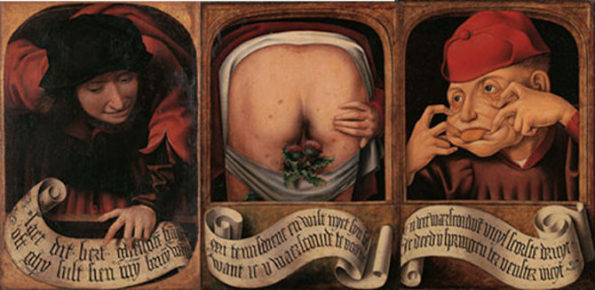Search
To search for an exact match, type the word or phrase you want in quotation marks.
A*DESK has been offering since 2002 contents about criticism and contemporary art. A*DESK has become consolidated thanks to all those who have believed in the project, all those who have followed us, debating, participating and collaborating. Many people have collaborated with A*DESK, and continue to do so. Their efforts, knowledge and belief in the project are what make it grow internationally. At A*DESK we have also generated work for over one hundred professionals in culture, from small collaborations with reviews and classes, to more prolonged and intense collaborations.
At A*DESK we believe in the need for free and universal access to culture and knowledge. We want to carry on being independent, remaining open to more ideas and opinions. If you believe in A*DESK, we need your backing to be able to continue. You can now participate in the project by supporting it. You can choose how much you want to contribute to the project.
You can decide how much you want to bring to the project.

The Grand Palais de París is currently holding the exhibition Carambolages, curated by Jean-Hubert Martin, the principal strategy in which is the collecting together of objects from all eras, cultures, materials, values, and geographical provenances in an order far removed from the traditional canons of Art History. The title of the exhibition is borrowed from billiards (a carom shot is when the white ball hits not one but two of the coloured balls) that serves in this case to announce the rather unorthodox organisation of the works presented in this exhibition, one based on free associations, according to one or more details. Adhering to a linear pathway, one piece leads to the next, just as in dominoes each piece has a knock on effect. It’s a playful proposition that aims for the spectator of the exhibition to be the one who, at each step, deciphers which elements leads to a point in the following.
The intention of the curator, in his own words, is to liberate the vision of the viewer from the traditional categories of art history, based on geographical, temporal, and cultural features that impose a reception of the works according to the context in which they are produced. One hardly needs say that the first room of the exhibition is dedicated to Aby Warburg’s Atlas Mnemosyne an obligatory port of call for anything proposing an undisciplined gaze upon artistic creation. The German art historian devoted his life to studying the migration of representations from the past to the present, by way of a transcultural confrontation of European culture with the timeless gestures observed in “primitive” civilisations. The boards, that form the Atlas Mnemosyne bring together images that show a certain visual proximity between them, organised in juxtaposition, paying no heed to aesthetic hierarchies or respect for the unities of time and space of their creation. This mise en scène enabled him to show, in a visual manner, the strength and timelessness of spiritual powers.
What one finds in Carambolages is a superficial reference to the unfinished work of Warburg, a recuperation of his iconographic method that has to be taken with a grain of salt. What does Jean-Hubert Martin propose with this game? Is there anything beyond the fact of reuniting artistic objects of a diverse provenance and nature in the same space? The central idea of this exhibition is the principle that the carom shot allows free associations, based on details or common elements shared by the works which make a new reception of the object possible, liberated from the stale pigeon-holing imposed by the traditional academic views. But what new interpretations are we talking about here? The exhibition doesn’t propose any reading based on this new perspective so much as limits itself to juxtaposing the objects in a closed circuit that only makes sense in itself, where the viewer’s reception is conditioned by the actual organisation of the works within the museum.
An obsession with “décloisonnement” has been recurrent in curatorial practices for years now. What began with a verification of the globalisation of the contemporary artwork, and a growing interest in the inclusion of artists and works coming from contexts, far removed from the historic foci of creation in the West led to the birth of biennials and events with an international flavour in all corners of the world. In Carambolagesthis is given one more twist, with the negation of the factor of time. The same curator for this exhibition directed the exhibition project Magiciens de la terre, an exhibition pioneering of this perspective held in the Centre Pompidou and the Halle de la Villette in París in 1989. On that occasion one hundred contemporary artists were brought together from across the world with the aim of “decentralising” the Western view of visual arts, eliminating the geographical and cultural frontiers that had governed it until the eighties. Magiciens de la terrewas praised for its efforts to force a broader gaze but was also criticised for various reasons, some of a political and others of an ontological order.
Concerning the criticisms of a political nature, the main one is that the relations of power are made explicit within the exhibition itself. The arithmetical inequality of Western to non-Western artists (that is to say those not born in Europe or the United States) does nothing more than reinforce the dynamics focussed on central-periphery already inherent in the world of contemporary art. This insistence on the country of origin for creators doesn’t reflect, on the other hand, how some of them have trained, work, or reside in the West. The main reproach of an ontological order referred to the aestheticising and maximising of the exoticism of the different artistic practices presented in the exhibition. One that reinforced a Euro-centric concept of creation enabling the display of ritual objects and pieces close to craft stemming from non-Western ambits, while the other 50% of the works responded to the criteria of contemporary art.
Three decades after Magiciens de la terre, we come to realise that the panorama hasn´t changed that much, however much the presence of international artists in exhibitions and museums no longer surprises us.
We can affirm that it’s not enough with an improvement in the representation of the diversity of national artistic traditions to talk of the “globalisation of contemporary art”, as this vision does nothing more than reinforce the relations of domination between centre and periphery. As Alain Quemin has shown, despite the opening of biennials, institutions, and international art fairs, the higher positions in the rankings and lists of contemporary art stars are still occupied by American and European creators, with anecdotal appearances by representatives from other countries. The exhibition title Des artistes chinois à la Fondation Louis Vuitton(Chinese artists at the FLV)(¡),(“Artistas chinos en la FLV”), at the Fondation Louis Vuitton in Paris serves as an anecdote. As if being Chinese was not enough to figure in it, as if there was no need to find a slightly less exotic title or indeed something that said a bit more about the art in question.
Carambolages functions as a “divertimento”, but one has to question its capacity to generate advances in Art History or change the average viewer’s perception of art in general. To mix objects of diverse natures and from different origins in the same space can serve to disinhibit the museum visitor, who suddenly feels free of the indoctrination of the academic of the day, but in this exhibition one can easily have the sensation of finding oneself in a Cabinet of Curiosities. When all is said and done, however, it is presented in the Grand Palais that was built precisely to house an event of a universal genre, the Universal Exhibition of 1900.

Glòria Guso is an art historian and a researcher in the social sciences. She was born in the periphery of Barcelona but lives in Paris and her second home is Germany. For her PhD thesis in sociology she studies the international mobility of the visual arts professionals. She writes, coordinates, edits, documents and criticizes.
"A desk is a dangerous place from which to watch the world" (John Le Carré)